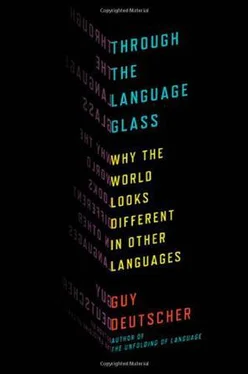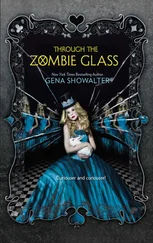Other types of color blindness are much rarer. A different type of dichromacy, called tritanopia, or in popular parlance blue-yellow blindness, arises in people who lack the long-wave (blue) cones. This condition affects only about 0.002 percent of the population (two people in a hundred thousand). A more severe defect is the lack of two types of cones. Those affected are called monochromats, as they have only one functioning cone type. An even more extreme case is that of rod monochromats, who lack all three types of cone and rely only on the rods that serve the rest of us for night vision.
THE EVOLUTION OF COLOR VISION
Human color vision evolved independently from that of insects, birds, reptiles, and fish. We share our trichromatic vision with the apes and with Old World monkeys, but not with other mammals, and this implies that our color vision goes back about thirty to forty million years. Most mammals have dichromatic vision: they have only two types of cones, one with peak sensitivity in the blue-violet area and one with peak sensitivity in green (the middle-wave cone). It is thought that the primate trichromatic vision emerged from a dichromatic stage through a mutation that replicated a gene and split the original middle-wave (green) receptor into two adjacent ones, the new one being a little farther toward yellow. The position of the two new receptors was optimal for detecting yellowish fruit against a background of green foliage. Man’s color vision seems to have been a coevolution with the development of bright fruits. As one scientist put it, “with only a little exaggeration, one could say that our trichromatic color vision is a device invented by certain fruiting trees in order to propagate themselves.” In particular, it seems that our trichromatic color vision evolved together with a certain class of tropical trees that bear fruit too large to be taken by birds and that are yellow or orange when ripe. The tree offers a color signal that is visible to the monkey against the masking foliage of the forest, and in return the monkey either spits out the undamaged seed at a distance or defecates it together with fertilizer. In short, monkeys are to colored fruit what bees are to flowers.
It is not clear to what extent the passage from dichromacy to trichromacy was gradual or abrupt, mainly because it is not clear whether, once the third type of cone emerged, any additional neural apparatus was needed to take advantage of the signals coming from it. However, it is clear that the sensitivity to color could not have evolved continuously along the spectrum from red toward the violet end, as Hugo Magnus argued it did. In fact, if viewed over a time span of hundreds of millions of years, the development went exactly the opposite way. The most ancient type of cone, which goes back to the premammalian period, is the one with peak sensitivity in the blue-violet end of the spectrum and with no sensitivity at all to yellow and red light. The second type of cone to emerge was the one with peak sensitivity in green, thus extending the eye’s sensitivity much farther toward the red end of the spectrum. And the youngest type of cone, from some thirty to forty million years ago, had peak sensitivity slightly farther toward the red end, in yellow-green, and so increased the eye’s sensitivity to the long-wave end of the spectrum even further.
THE BRAIN’S PHOTOSHOP
All the facts mentioned so far about the cones in the retina are correct to the best of my knowledge. But if you are under the impression that they actually explain our sensation of color, then you have been coned! In fact, the cones are only the very first level in a highly complex and still largely unknown process of normalization, compensation, and stabilization-the brain’s equivalent of the “instant fix” function of picture-editing programs.
Have you ever wondered why cheap cameras lie about color all the time? Why is it, for example, that when you use them to take pictures in artificial light indoors, suddenly the colors look all wrong? Why does everything look unnaturally yellow and why do blue objects lose their luster and become gray? Well, it’s not the camera that is lying; it’s your brain. In the yellowish light of incandescent lamps, objects actually do become more yellow and blues do become grayer-or at least they do to any objective measuring device. The color of an object depends on the distribution of wavelengths that it reflects, but the wavelengths reflected naturally depend on the wavelengths of the light source. When the illumination has a greater proportion of light in a certain wavelength, for instance more yellow light, the objects inevitably reflect a greater proportion of yellow light. If the brain took the signals from the cones at face value, therefore, we would experience the world as a series of pictures from cheap cameras, with the color of objects changing all the time depending on the illumination.
From an evolutionary perspective, it’s easy to see why this would not be a very useful state of affairs. If the same fruit on a tree looked one color at noon and a different color in the evening, color would not be a reliable aid in recognition-in fact, it would be a positive hindrance. In practice, therefore, the brain does an enormous amount of compensating and normalizing in order to create for us a relatively stable sensation of color. When the signals from the retina do not correspond to what it wants or expects, the brain normalizes them with its “instant fix” function, which is known as “color constancy.” This normalization process, however, is far more sophisticated than the mechanical “white balance” function of digital cameras, because it relies on the brain’s general experience of the world and, in particular, on stored memories and habits.
It has been shown, for example, that long-term memory and object recognition play an important role in the perception of color. If the brain remembers that a certain object should be a certain color, it will go out of its way to make sure that you really see this object in this color. A fascinating experiment that demonstrated such effects was conducted in 2006 by a group of scientists from the University of Giessen in Germany. They showed participants a picture on a monitor of some random spots in a particular color, say yellow. The participants had four buttons at their disposal and were asked to adjust the color of the picture by pressing these buttons until the spots appeared entirely gray, with no trace of yellowness or any other prismatic color left. Unsurprisingly, the hue that they ended up on was indeed neutral gray.
The same setup was then repeated, this time not with random spots on the screen but with a picture of a recognizable object such as a banana. The participants were again requested to adjust the hue by pressing buttons until the banana appeared gray. This time, however, the actual hue they ended up on was not pure gray but slightly bluish. In other words, the participants went too far to the other side of neutral gray before the banana really looked gray to them. This means that when the banana was already objectively gray, it still appeared to them slightly yellow! The brain thus relies on its store of past memories of what bananas look like and pushes the sensation of color in this direction.
The involvement of language with the processing of visual color information probably takes place on this level of normalization and compensation. And while it is not clear how this works in practice, it seems plausible to assume that the concepts of color in a language and the habit of differentiating between them contribute to the stored memories that the brain draws on when generating the sensation of color.
INTRODUCTION: LANGUAGE, CULTURE, AND THOUGHT


“There are four tongues worthy of the world’s use”: Jerusalem Talmud, tractate Sotah, p. 30a ().
Читать дальше













